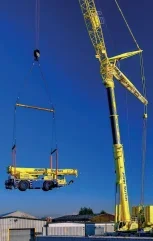
In the UK crane hire and contract lifting specialist John Sutch Cranes has put out an urgent ‘call for collaboration’ to help ensure the sustainable growth of its business whilst still maintaining compliance with relevant regulations.
With a legacy spanning 35 years in the industry, and a fleet of 34 cranes operating across the UK, John Sutch Cranes, operating out of depots in Liverpool and Manchester, is well placed to not only service its customer base but to also highlight the challenges of operating a crane company on a national level. But what exactly is it that’s impacting John Sutch Cranes’ growth?
In recent years the business has been hit by what John Sutch, owner of the business, calls “unnecessary restrictions” by local councils and police forces – despite his company meeting every requirement to get his cranes on the road and servicing customers.
These travel restrictions, Sutch claims, are negatively impacting operational efficiency and adding costs.
“While we understand the importance of regulations concerning heavy abnormal loads it’s crucial to highlight that our operations primarily involve plant hire which falls outside the scope of the current legislation,” says Sutch. “Moreover, we take great care to ensure compliance with axle weights and other relevant dimensions outlined in the application process.”
INCONSISTENT INTERPRETATION
“One of the major challenges we are encountering is the inconsistency between councils and police forces regarding the interpretation and enforcement of these regulations,” Sutch continues. “This lack of uniformity not only adds to our operational burden but also leads to financial losses.
“Additionally, the fact that applications are often handled by individual personnel within the organisation exposes us to subjective decision-making processes, which can further exacerbate the situation.”
Sutch is not alone in experiencing these operational restrictions. “We are hearing that crane operators and hauliers moving abnormal sized loads are pulling out of the market because embargoes on travel between certain hours are making jobs impossible, financially unviable, or having seriously negative impacts on workforces,” confirms Richard Beresford, chief executive of the UK’s National Federation of Builders (NFB).
Things came to a head in England and Wales over Easter when some UK crane hire companies were forced to shut at least four days because police effectively banned them from the roads.
Across much of the UK mobile cranes are no longer allowed on the roads between 7am and 9am in the morning and between 4pm and 6pm in the afternoon. In London restrictions are even stricter with the Met Police banning all mobile cranes, even small two-axle ones, from the city between 6am and 10am in the mornings on weekdays and between 3.30pm and 8pm in the evenings. And at the weekend, and bank holidays, cranes are not allowed to move in London between 10.30am and 8pm. As anyone who works in the industry knows, however, the need for a crane does not always occur at a time that suits the police!
SOLUTION FINDING
So what’s the solution? A good place to start would be by looking to the examples set by crane and transport trade associations around the world that are well used to fighting their corner.
The problem with the UK’s restrictive regulations has clear parallels with many of the issues experienced by crane and specialised transport companies working across European boarders, and beyond.
For years the European Association of Abnormal Road Transport and Mobile Cranes (ESTA) has been campaigning for the reform and harmonisation of the rules governing heavy transport and abnormal loads throughout the European Union. And, encouragingly, its campaign is at long last gaining momentum.

ESTA reports that its reform proposals have been backed by the Transport and Tourism (TRAN) Committee of the European Parliament and that now revisions to the EU’s Weights and Dimensions Directive have been ratified by the full European Parliament before going into a process of consultation between the European Council, Parliament and Commission.
These include the long-awaited Europe-wide adoption of the standard SERT documentation for abnormal load vehicle registration – a move that ESTA has supported for many years. SERT, the Special European Registration for Trucks and Trailers, is intended to reduce the paperwork and bureaucracy faced by the industry.
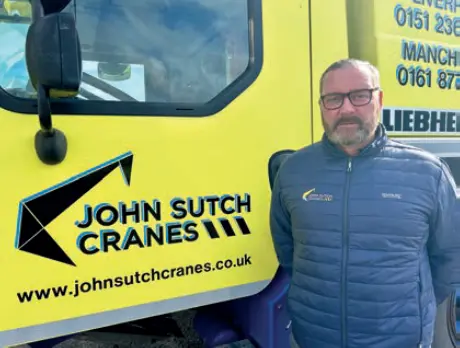
There is still a long way to go yet before ESTA’s proposals are fully adopted but the organisation says its arguments are being taken more seriously than at any time in the recent past.
This should be heartening for UK companies like Sutch as it demonstrates change through collaboration and dialogue really is possible.
“ESTA is increasingly listened to by our politicians and regulators who are at long last beginning to understand the great significance of the work carried out every day by our industry,” affirms current ESTA president Fabio Belli in ESTA’s recently released 2023 annual review.
“We are increasing ESTA’s resources, developing our lobbying expertise in Brussels and maximising our impact by working with external organisations that share our aims,” Belli outlines.
“A key element in our strategy is to develop working relations with fellow organisations dealing with similar issues, to maximise our profile and impact,” says ESTA director Ton Klein.
ESTA has, for example, has long had close working relationships with crane manufacturers through FEM – the European Materials Handling Federation – and is a founder member of the International Crane Stakeholders Assembly (ICSA). Over the last 12 months ESTA has focussed its collaborative strategy. In April 2023 leading crane expert Klaus Meissner joined ESTA’s management team. “Only together will we be able to master the challenges of the coming years,” says Meissner.
In May 2023 ESTA signed a Memorandum of Understanding with ECTA (the European Chemical Transport Association) with both organisations working together to lobby for improvements in transport infrastructure and regulation, best practice, and safety.
And in August 2023 ESTA joined ESPORG, the European Secure Parking Organisation representing all parties interested in safe and secure truck parking to lobby for improved abnormal transport parking facilities.
In addition, ESTA has become active in Verbändeinitiative Großraum- und Schwertransporte (VI GST), a new and influential campaign pressing the German government to take urgent action to improve the increasingly difficult conditions faced by large and heavy transport in the country.
“As we become a more visible association, so the national and international media become more interested in what we have to say and the issues that concern us, which in turn raises our profile still further,” Belli says.
EFFECTIVE EDUCATION
Across the Atlantic USheadquartered organisation Specialized Carriers & Rigging Foundation (SC&RF), which works to benefit the members of international lifting and transport trade association Specialized Carriers & Rigging Association (SC&RA) believes education is a key tool in overcoming misunderstanding and ignorance amongst rule-makers.
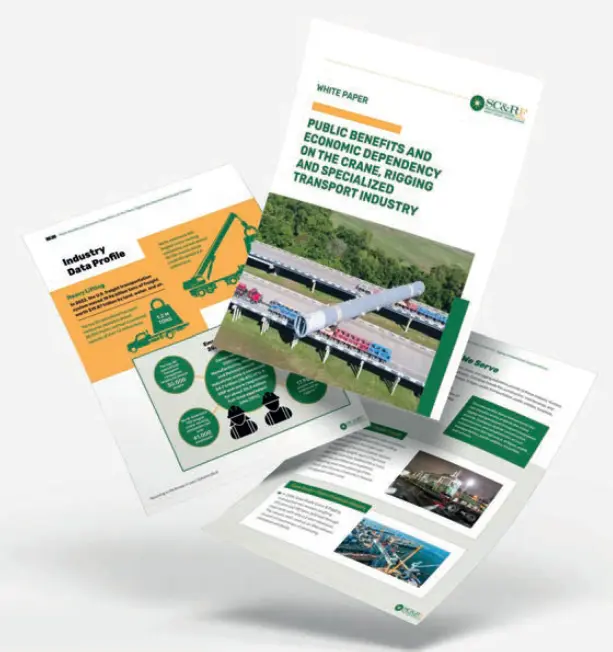
It has recently published, for example, a white paper designed as a resource for business owners and advocacy groups in the specialised transportation, crane and rigging industries to educate those outside the industry, highlight the shared objectives between the industry and society, and demonstrate the impact of those working in the industry.
“Despite the role of the specialised transportation, crane and rigging industries in the growth and development of our society, the unique challenges and regulations encountered are often not well understood by the public, elected representatives and government officials at a local, state or federal level,” says SC&RF director Jackie Roskos.
As such, the white paper was developed to enable readers to understand the basics of our industry while also setting the stage for targeted discussions.
“This paper is meant to be used in a variety of ways to educate communities, public officials, and customers,” Roskos notes. “The information and perspective put forth should allow anyone establishing rules or working with companies in these or related lines of work, a deeper understanding of how these industries function, and the fundamental value they bring to society.”
A copy of the white paper can be downloaded for free here: https://scr-foundation.org/2021- workforce-study-state-of-theindustry- copy/.

North of the USA, industry association the Canadian Crane Rental Association (CCRA) has also made heartening progress getting government transport authorities to update their permitting policies to permanently allow increased weights for all terrain cranes on Alberta roads. Read more about this in News on page 12.
PINCH POINTS
Returning to the UK, the restrictive regulations currently being experienced by Sutch, and others, are, understandably, frustrating. “It’s a nationwide problem,” says Paul Parry, sales director at John Sutch Cranes. “Other companies will be feeling the same pinch points. It cannot continue!
“In a time where we need construction to stimulate the economy we are being constrained to make the positive impact we know we can make on construction sites. This is happening, frustratingly in some cases, by individuals who hold the power to say ‘no’ for reasons we cannot understand nor agree with.”
Frustration can be seen at ESTA, too. “Our industry still faces a plethora of petty, national, bureaucratic and inefficient obstacles that raises costs for our clients and society as a whole,” says Belli.
“A productive nation is nothing without a well-functioning construction industry, but we are increasingly finding that the operational side of construction is far from the minds of decision makers,” echoes NFB’s Beresford.
With livelihoods on the line it is no wonder there is great frustration – and even calls for government intervention.

“We need the Government to act quickly and sort out this mess,” says Rico Wojtulewicz, head of policy and market insight at the NFB. “A temporary Written Ministerial Statement removing all embargoes on travel for abnormal loads would give the Government time and space to have a consultation on how travel restrictions should work nationally. Letting local police forces and councils make decisions on travel embargoes, particularly when they are not providing evidence of their rationale, is creating a logistical nightmare and another major barrier for UK productivity.”
ON TRACK
As the progress made by ESTA and CCRA demonstrate, however, through collaboration and dialogue positive change can be effected.
And in this respect John Sutch Cranes is on the right track. Already John Sutch and Paul Parry have enlisted the support of UK trade association the Construction Plant Hire Association (CPA), they are also in talks with local MPs, and letters have been issued to the Mayor of Liverpool and the Mayor of Manchester.
“We believe that open communication and cooperation between my business and the councils is essential to finding mutually beneficial solutions that uphold regulatory standards while enabling us to continue our operations effectively,” says Sutch. “We are confident that through dialogue and collaboration we can work towards resolving the current situation and ensure the sustainable growth of our business while maintaining compliance with relevant regulations – but people have to come to the table.”
This call to the table is also echoed by ESTA. “ESTA has an extraordinarily welcoming and cooperative culture which should be cherished,” says Belli. “We are a group that is committed to improving our industry for the benefit of all…
“We need to persuade more small and medium-sized firms to become involved in our work to ensure we adequately reflect their concerns and priorities… The overall message is simple. We are stronger together.”
UK MARKET SNAPSHOT FROM LIFTING SOLUTIONS PROVIDER AINSCOUGH
Martin Nobes, sales director at UK lifting solutions provider Ainscough Crane Hire, on issues including proactively engaging with the authorities, the importance of planning, safety, and areas of industry growth.
2024 has been an interesting start, to say the least, enduring some challenging head winds (if you excuse the pun). Aside from weather conditions playing a big part into a slower start across the sector, the other current challenge has been the well-published ‘minefield’ regarding routing and travelling embargos. Travelling cranes to site have increasingly become more complicated and now require a high level of planning expertise and additional resource to ensure customers receive cranes on time. This has also impacted customers and we have had to reset their expectations around planning leadtimes and flexibility.
At Ainscough we look to minimise this impact by engaging early in the planning process with customers to help navigate the different and inconsistent interpretation of legislation across different regions. It is worth noting that we have had positive results from some police forces by proactively engaging directly with key decision makers, and I really pleased that these relationships are now progressing, which is allowing us to find practical solutions and ultimately enable us to get critical equipment to site as efficiently as possible. This coupled with our Earned Recognition standard has been well received by the authorities.
General expectations for the remainder of the year look promising with some key projects (currently running behind or previously delayed) looking to catch up, as well as new projects starting. We see a step up each year as weather improves but expect this year to be more significant compared to previous due to the exceptionally poor winter weather. For us, early planning and engagement is even more important now to balance availability against demand both with equipment and personnel, to make sure we meet our customer’s needs.
We added the LR1700 crawler crane to our fleet at end of last year, and this indicates the sort of lifting operation where we believe we will see growth for the industry – its towards the larger infrastructure projects, the transition from CP6 to CP7, grid renewal / electrification, and general infrastructure projects, to highlight a few areas where we are focused on increasing our capability and support for customers. A related area of growth we see more of is the requirement for larger cranes to support the modular building concept; as the construction industry develops new manufacturing capabilities, loads are typically now larger, so we’re making sure we’re geared up with the right equipment to support our customers.
Our strategy is to be recognised as the national high value lift service supplier of choice across the UK. This means we must provide the highest standards of safety, compliance, and competency with our operators, supported by the best equipment, network, management, and technology to deliver that service. Our number one priority is safety, and we will continue to push for right level of legislation and best practice standards for crane safety. In this space we also see technology and data availability via real-time reporting as a key enabler of improved safety and effectiveness, and as a result this is a focus for our business over the next couple of years.
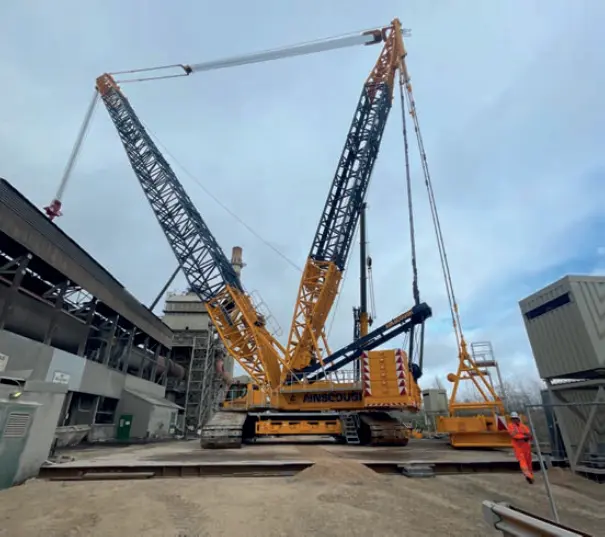
With more customers are now focusing on the environmental impact of their operations (and legislative requirements coming for Scope3 reporting), we are well positioned with Ainscough demonstrably a leader in this space, becoming the first national crane company in the world to achieve accredited Carbon Neutral status. We have also delivered numerous wider best practice initiatives and innovation, such as monthly best driver recognition, lighter crane tackle and tackle boxes, and introducing the first hybrid mobile crane which entered our fleet this year. Our fleet replacement programme also sees a major investment in the latest tractor units from Scania, and cranes from Liebherr, with have significantly improved duties that not only save customers money but have environmental benefit from the latest technologies.
MARKET OVERVIEW FROM YANNICK SEL, GROUP PROJECTS COMMERCIAL DIRECTOR, AT INTERNATIONAL HEAVY LIFT AND TRANSPORT SPECIALIST SARENS
Yannick Sel, group projects commercial director at Sarens, speaks exclusively to Cranes Today on industry growth areas, the energy transition, fleet demand, nuclear projects, plus more…
How has the European market for specialised heavy lifting and transportation been so far in 2024?
The market has been very busy and will remain so for the remainder of the year going into 2025.
What application areas are currently most driving growth?
The energy transition is in full swing; this particularly shows for Sarens in the offshore wind market. We also see a trend that projects are becoming larger in size (more MW) and foundations such as jackets and monopiles are gaining in size and weight requiring more and heavier equipment to handle them. We continue to see these trends for quite some time. At the same time we notice that some (pilot) floating offshore wind projects will kick off. This is only a preamble to commercial scale projects in the future. Whereas in the past only the ‘classic’ countries were getting involved in offshore wind we now see the market expanding to other countries. This is also proof that more and more governments are seeing a place for offshore wind in their energy mix. Baltics, Nordics, Poland, … just to name a few. The civil industry is also keeping our teams occupied. We recently installed the last bridge over the Albert Channel, a bridge heightening programme taking several years, allowing the inland shipping to take a full row of containers extra, taking some 8.000 trucks off the road each day.
And last but not least, the general industry comprising data centres, semiconductor plants etc. is also seeing an increase in demand.
Which items in your fleet are most in demand? Why is this?
We particularly see high-capacity crawler cranes and ring cranes being in high demand due to the ever-increasing size and weight of the wind turbines and foundations.
Have you needed to expand your fleet to meet any particular growth areas?
Sarens continuously keeps renewing its fleet of cranes and SPMTs. Newer generation SPMTs also have higher capacity.
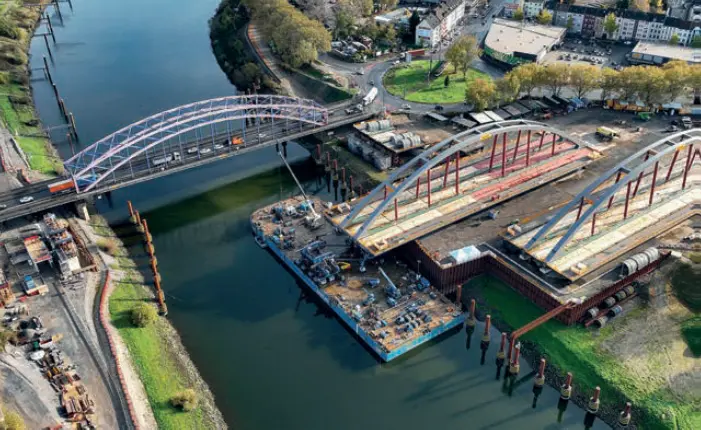
Have you seen a decline in work in any particular areas? If so, where, and what are the reasons behind this?
The classic oil and gas (read refineries in Europe) projects have a different profile than some 5-10 years ago. The energy transition is the main reason for this.
What have been the main challenges, if any, for doing business recently and how is Sarens overcoming these challenges?
There are a lot of different innovative projects, especially considering the different floater designs. Will all receive a Final Investment Decision (FID) and how certain are the timelines? Being able to predict and forecast these developments is challenging.
What are the company’s plans for the future? Do you have a growth strategy in place that you can outline?
We have spoken a lot about offshore wind yet we must also not forget the nuclear industry for which several countries are gearing up as well. Having supported the construction of the Hinkley Point C nuclear power plant in the UK, Sarens is also in close collaboration with other nuclear projects in Europe on which they need our expertise and Sarens SGC ring cranes which will be operated electrically. This is our energy transition.
Are there any other things you’d like to highlight?
Sarens is also starting up its operation on Ineos’ Project ONE in Antwerp, Belgium. There we will be utilising a mix of high-tech equipment, including telescopic cranes, SPMTs, barges and CC8800-1 crawler cranes, to install modules, columns and a flare.
COMPANY SNAPSHOT: DIVERSIFICATION AND EXPANSION FOR BKL
German crane firm BKL is well-positioned for growth despite challenges of declining home building sector.
BKL Baukran Logistik (BKL) is a German crane rental, sales and service provider, headquartered in Munich with branches in Ingolstadt, Rosenheim, Frankfurt, Aschaffenburg, Nuremberg, Ansbach, Hannover and Hildesheim. It employs over 360 people.
With 55 years of experience BKL is one of Europe’s largest manufacturerindependent, full-service providers of crane solutions. It has over 500 tower cranes in its fleet and more than 300 mobile cranes, mobile construction cranes, trucks, loader cranes and low-loaders.
The company specialises in crane rental, sales and service and it is growing in size. In 2023 it opened three new locations – in Aschaffenburg, Nuremberg and Ansbach – for tower crane rental.
The Nuremberg and Ansbach locations were due to BKL’s takeover of Kran-Knoll, including the mobile crane and transport services it provided.
BKL also offers assembly, repair and maintenance, heavy haulage, special transport and industrial assembly services from these locations.
BKL has also expanded into new business areas, such as industrial assembly and additional crane sales services (including guarantees, hire purchase and financing offers). As such, BKL now offers a broad range of machines and services that goes far beyond the field of home construction, which the company says is currently on the decline in Germany.
BKL offers manufacturer-independent expert advice, demonstration cranes (from Liebherr or Potain), and it is the exclusive distributor of BKL System Cattaneo and Grúas Sáez cranes in Germany and Austria.
All its cranes are serviced and repaired by experienced, factory-trained, technicians. In addition to BKL’s consulting and logistics services it can also provide transportation and erection support for buyers of selferecting and top-slewing cranes.

A new service BKL offers is the sale of used cranes and it now buys and trades used construction cranes.






